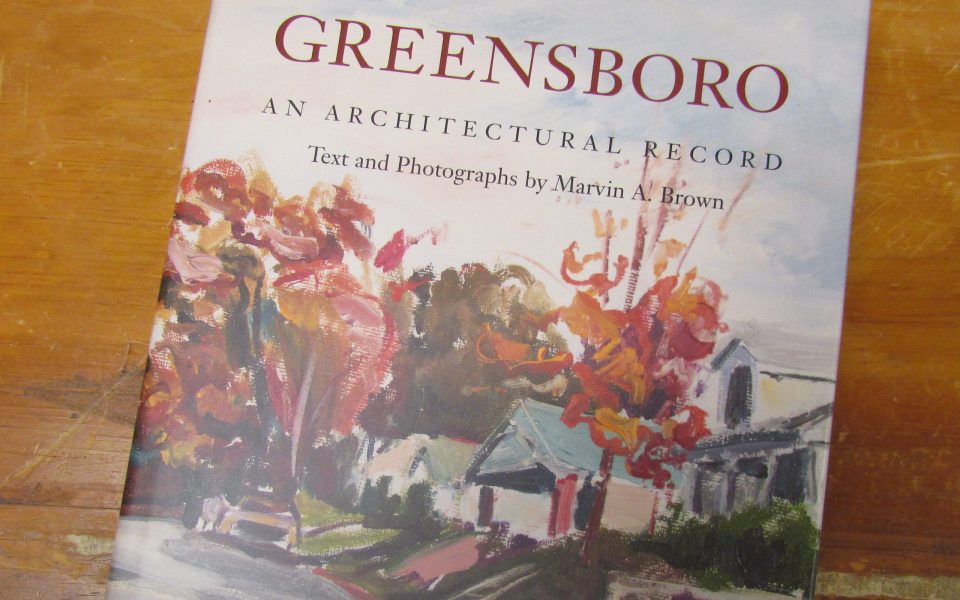Ever since this hardbound volume arrived at our office — courtesy of Preservation Greensboro Development Director John Graham, I’m told — I’ve been unable to resist poring through its pages.
Compiled by Marvin A. Brown and published by Preservation Greensboro in 1995, this 447-page volume is an indispensable guide to the building stock of Greensboro’s historic core, from the mill villages in the northeast to Lindley Park, from exclusive Irving Park to working-class Glenwood, from predominantly African-American areas in the east to the pre-Revolutionary War Quaker settlement near present-day Guilford College.
The brief history of the relatively young city’s settlement and development is helpful, but the payoff is in the “Neighborhood Histories and Inventories of Buildings” section, which comprises roughly three quarters of the book. With a thumbnail black-and-white photo, an address and a capsule history of each building, this is gold for a newspaper such as ours that is dedicated to charting the reinvention of our cities and explaining how we got to be the way we are. For virtually any noteworthy building more than 75 years old, there’s information about the its architectural style, its original owner and the date it was built.
Sure, you can find the more prominent structures like the Carolina Theatre, the Jefferson-Pilot Building and War Memorial Stadium, but how about that long, stucco Spanish Colonial Revival-style building on West Gate City Boulevard between Tate Street and Freeman Mill Road? It was formerly the home of Carolina Baking Company and was likely built in the late 1920s. Intrigued by the recent resurgence of activity at the intersection of Spring Garden and Chapman streets? You might be interested to know that the area emerged as a commercial hub in the 1910s and that the building now occupied by Freeman’s Grub & Pub was built as David S. Freeman Grocery Store between 1915 and 1920.
There’s no evidence of favoritism towards predominantly white neighborhoods like College Hill, Westerwood and Lindley Park. Fabulous architecture can be found throughout black neighborhoods including Arlington Park and Dudley Street. Take the John A. Hodgin House, located near the intersection of Martin Luther King Jr. Drive and Gate City Boulevard. Built for a real estate developer between 1910 and 1913, it proves that even as trendy neighborhoods like Fisher Park were beginning to take off, the south side still easily held its own. The Neoclassical Revival-style dwelling, Brown writes, “stands out for its uniqueness as well its size and fine finish, which includes a two-story portico of paired Ionic columns; a one-story, full-façade front porch with circular bays, Ionic columns, turned balusters, and a balcony; pedimented dormers and a porte-cochere.” Yet I take as much delight in the entry for a bungalow with a California-style porch built in Piedmont Heights in the late 1920s for W. Paul Whitley, the Greensboro Police Department’s fingerprint expert.
There are larger stories about urban development here, too. Ever wondered how State Street came to be such a compact and walkable commercial center in a city otherwise cursed by sprawl? Unlike many early 20th Century developments, the author explains, the adjacent McAdoo Heights neighborhood “provided many of the amenities of a small town,” and its bars in particular drew residents from the neighboring mill villages, which were dry. Yet, by “the mid-1980s the sway of McAdoo Heights’ wealthy neighbor to the west, Irving Park, overcame that of the mills, transforming State Street into an avenue of upscale shops and restaurants.”
You don’t read this book cover to cover or look for big, overarching themes; you take in its granular detail little by little and return from time to time to mine its small epiphanies.
Join the First Amendment Society, a membership that goes directly to funding TCB‘s newsroom.
We believe that reporting can save the world.
The TCB First Amendment Society recognizes the vital role of a free, unfettered press with a bundling of local experiences designed to build community, and unique engagements with our newsroom that will help you understand, and shape, local journalism’s critical role in uplifting the people in our cities.
All revenue goes directly into the newsroom as reporters’ salaries and freelance commissions.


Leave a Reply